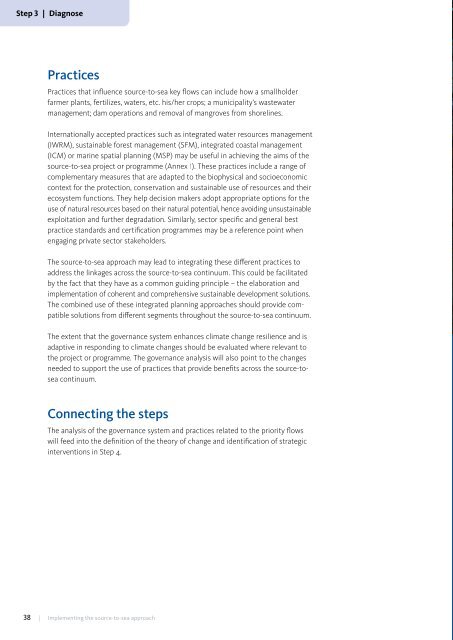Source-to-Sea Practitioners Guide
The source-to-sea approach directly addresses the linkages between land, water, delta, estuary, coast, nearshore and ocean ecosystems in support of holistic natural resources management and economic development.
The source-to-sea approach directly addresses the linkages between land, water, delta, estuary, coast, nearshore and ocean ecosystems in support of holistic natural resources management and economic development.
Create successful ePaper yourself
Turn your PDF publications into a flip-book with our unique Google optimized e-Paper software.
Step 3 | Diagnose<br />
Practices<br />
Practices that influence source-<strong>to</strong>-sea key flows can include how a smallholder<br />
farmer plants, fertilizes, waters, etc. his/her crops; a municipality’s wastewater<br />
management; dam operations and removal of mangroves from shorelines.<br />
Internationally accepted practices such as integrated water resources management<br />
(IWRM), sustainable forest management (SFM), integrated coastal management<br />
(ICM) or marine spatial planning (MSP) may be useful in achieving the aims of the<br />
source-<strong>to</strong>-sea project or programme (Annex 1). These practices include a range of<br />
complementary measures that are adapted <strong>to</strong> the biophysical and socioeconomic<br />
context for the protection, conservation and sustainable use of resources and their<br />
ecosystem functions. They help decision makers adopt appropriate options for the<br />
use of natural resources based on their natural potential, hence avoiding unsustainable<br />
exploitation and further degradation. Similarly, sec<strong>to</strong>r specific and general best<br />
practice standards and certification programmes may be a reference point when<br />
engaging private sec<strong>to</strong>r stakeholders.<br />
The source-<strong>to</strong>-sea approach may lead <strong>to</strong> integrating these different practices <strong>to</strong><br />
address the linkages across the source-<strong>to</strong>-sea continuum. This could be facilitated<br />
by the fact that they have as a common guiding principle – the elaboration and<br />
implementation of coherent and comprehensive sustainable development solutions.<br />
The combined use of these integrated planning approaches should provide compatible<br />
solutions from different segments throughout the source-<strong>to</strong>-sea continuum.<br />
–<br />
The extent that the governance system enhances climate change resilience and is<br />
adaptive in responding <strong>to</strong> climate changes should be evaluated where relevant <strong>to</strong><br />
the project or programme. The governance analysis will also point <strong>to</strong> the changes<br />
needed <strong>to</strong> support the use of practices that provide benefits across the source-<strong>to</strong>sea<br />
continuum.<br />
Connecting the steps<br />
The analysis of the governance system and practices related <strong>to</strong> the priority flows<br />
will feed in<strong>to</strong> the definition of the theory of change and identification of strategic<br />
interventions in Step 4.<br />
38 | Implementing the source-<strong>to</strong>-sea approach

















